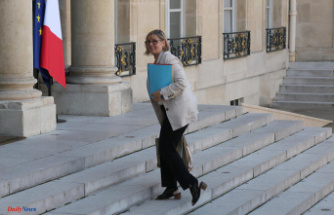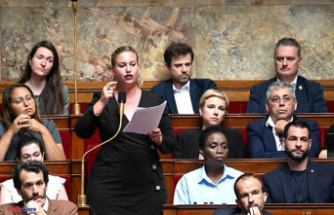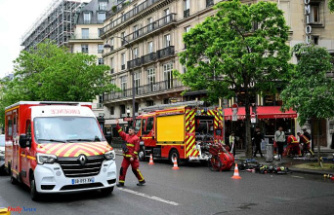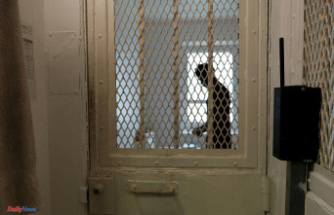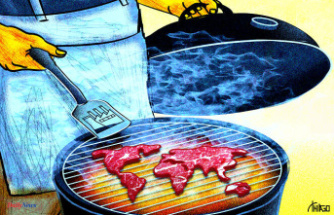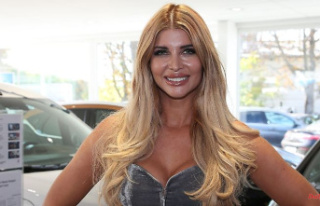The Fasanenstraße in the west of Berlin has changed from the luxury shopping mile to the art Eldorado. Here you will find shops that sell photo prints for everyone, the venerable Grisebach auction house, the Literaturhaus with its dreamlike, quiet garden and various internationally active galleries. Alfred Kornfeld, just called Freddy by everyone, dared to make a new start here and has been indispensable ever since. He shows contemporary art in two of the magnificent Gründerzeit houses. He founded his Galerie Kornfeld ten years ago. The "68projects" project room was added in 2015 for open partnerships, residencies and cooperation. A conversation with the very open, always casually dressed career changer about professional fields, surprises, art dealing and being human.
ntv.de: As a gallery owner, how do you decide on an artist?
Freddy Kornfeld: It's a decision made by our entire team and it's important to me. We sit together, discuss, discard, reflect, talk about the positions and ask ourselves whether we can identify with the art. What relevance do we recognize, are we willing to develop the position in the medium term - even if it cannot be placed immediately. Do these works potentially make a difference in art in the next 30 years? What is really new and creates a discourse? Where is our clientele? What do you expect from us? Does the price range fit into the gallery's portfolio? It is a subtle and complex decision-making process that takes a wide variety of factors into account. My observations of art over the past decade show me how great the demand for the concrete is. We seek anchorage in our complex and often unmanageable world.
Representational art offers more security for the buyer or viewer?
Our eyes are looking for the familiar and thus for safety and security. Hence the need for the representational in art. At the same time, however, we as gallery owners see great importance in abstract art. That opens the room, poses riddles and provides unexpected answers.
Speaking of unexpected, what surprised you over the past ten years?
The harmonious coexistence, the constructive and lively cooperation among our artists, among the collectors and the people who have accompanied us for ten years. Our team, the cleaning staff, the picture framer, the graphic artist, the photographer. We all celebrated our wonderful anniversary together. All contribute to the glow. It was a big surprise that my partner Anne Langmann gave our anniversary speech. Anne accompanies me more in the background and not actively in the business. She is my sounding board, I talk to her about everything related to the gallery.
Why did you decide to go into the art trade ten years ago, at the age of 46?
I was a banker for 18 years and witnessed trading in investment banking. After banking, I expanded, restructured and successfully sold an IT company from 2006 onwards. With the gallery we are also active as entrepreneurs. But the meaning is different for me. It fills me with purpose and joy to work with artists and experience them as an extended family. It's not just about buying and selling. Being a gallery owner is enriching. The desire to work with people, to accompany their development and to experience them is motivation and inspiration.
Have you used yourself up in the jobs before?
Being a banker was an exciting time, and so was the IT industry. But I wanted to do something new in the second half of my life, grow spiritually, develop myself further, conquer a new field. The art that had fascinated me for a long time and with which I dealt intensively was obvious.
What gave you the impetus to leave IT and conquer a third professional field with art?
My partner Mamuka Bliadze wanted to start his own gallery in 2012. Anne and I wanted to be actively involved in this project right from the start because we wanted to give the artists a supportive and challenging framework. Mamuka ran the gallery for the first few years when I was still involved in other areas. In 2016 I got to the point where I decided to just focus on the gallery. That was a good and right decision.
Looking back, what was the biggest mistake?
A group exhibition called "Mona" (laughs). The most faked picture in the world is the "Mona Lisa". One of the 16 positions we showed was a picture by the art forger Wolfram Beltracchi. We were still young and naive, and then we were shocked by the violent reactions to Beltracchi. Today we are ten years wiser...
Did you have to prove yourself even more afterwards?
We are all constantly being challenged. Being challenged triggers growth. And waxing can be painful. As a "new kid on the block" I repeatedly had to deal with criticism. I am grateful that we have been able to play in two rooms at a high level for ten years. It's great that we give many international artists a chance to show us their art. We have a residency program and invite you to live and work in Berlin. We sit together as a team over our program for 2023 and ask what we are about. What are we showing? Are we aligned? But we also ask ourselves, in what times are we living? What do we want to show against this background?
What topics are you currently working on?
How should we live together in a society? We need to talk about women's rights in Iran. A person is being tortured to death because the veil was not worn properly. This concerns all democratic societies, and we must demand it. In Italy the voter turnout was ten percent lower. At the same moment we have a war only three hours away. How do we deal with that? We also live that in the gallery. We don't show political art. But we are a gallery that definitely shows socially critical works that are political in their statement.
Is there a common ground between the gallerist and the art collector that you are?
The love of art, showing art and collecting art have a lot to do with me personally. But as a gallery owner, I am part of my team and committed to my artists. Collecting is Anne's and my great private passion.
How would you describe your team?
Lively and smart people of all ages, origins and nationalities and different professional fields. Everyone brings their own perspective on art. The variety of professional backgrounds, be it, for example, the doctorate in art history, the former publisher, my banking. All these different skills characterize our great team.
Were there moments when you thought: "What am I actually doing here?"
Yes, of course, I think everyone feels that way. And shark tanks are everywhere. But I also know that the overall composition of quality, standards, knowledge and experience is convincing. I am a philanthropist and I want to be a bridge builder.
They are socially involved in various ways. Supported artists in need during the pandemic and accompanied the ACHSE, an association that gives people with rare diseases a voice. Where does this interest in people come from - beware of the cliché - this is not a matter of course for bankers ...
This is my essence. And my upbringing was also formative here: "Be open, look left and right and bond with other people." In these difficult times, I wish more empathy - on the part of politicians, but also as a matter of course among people. To my team, I always say that we have to be good to ourselves and to our artists. You should work on that every day. It's like in any relationship.
Would you start a gallery again?
Again and again. A gallery means constantly getting involved and learning. It was the right thing to do. A big project – never ending.
Juliane Rohr and Sabine Oelmann spoke to Alfred Kornfeld
Galerie Kornfeld, Fasanenstraße 26, 10719 Berlin, all information here


